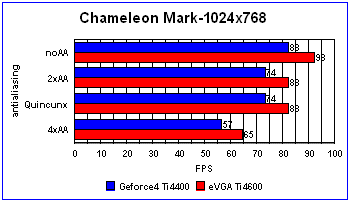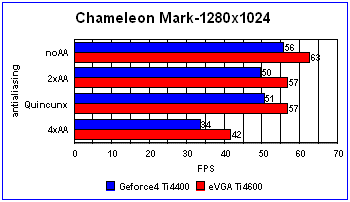eVGAs current king-of-the-hill is a rather interesting version of the NVIDIA Geforce4 Ti4600 Graphics Processing Unit (GPU), the eVGA e-Geforce4 Ti4600. Not only is it a version of NVIDIAs top shelf 3D GPU but it incorporates a rather eccentric cooling system and VIVO (Video In/Video Out) features through a single S-video port. With this review well look at the specifications of this card, what eVGA has done to maximize the usability of the card, and at some gaming and synthetic benchmarks.
The Card
 |
The card arrived in the standard fare, cardboard box with a plastic inner tray. The picture at left shows the front side of the card. As you can see, eVGAs ACS2 (Active Cooling System ver.2) is a sizeable arrangement. It is based on a large aluminum plate which spans over both the GPU and the memory chips. Over the GPU, a ducted fan is attached with internal aluminum fins. Over the memory, youll note a thin bar of copper that wraps around the GPU location, spanning over the four memory chips. This bar of copper serves to pipe the memory heat to the surrounding aluminum plate. |
| A slightly different arrangement is used on the back of the card to cool the four memory chips located there. The copper strip is used to pipe the memory to two small aluminum heatsinks. |  |
Also included in the packaging are four CDs: eVGAs driver disk, NVIDIA technology demos, and Cyberlinks PowerDVD XP and PowerDirector Pro ME. The PowerDirector software is used for creating movies via the VIVO portion of the e-Geforce4 Ti4600. For fun’s sake, eVGA has packed the demo CD with a ton of NVIDIA’s showcase movies of rendered scenes. The list is long and worth checking out, just to see how nicely your new card is working.

To support the VIVO capabilities, the e-Geforce4 Ti4600 also came with a S-video patch cable and a VIVO patch cable which includes both composite and S-video input and output. Not only does the cable connection type options give this card a great maount of flexibility, but these cables are also fairly long, as you can tell from the picture below. This is a nice, small added detail which makes setting up your VIVO system very easy and flexible.

Unfortunately, I do no currently have the ability to test this feature. BUT, I intend to remedy this very soon…be sure to look back here for a full VIVO review.
Specifications
The specifications of eVGAs e-Geforce4 Ti4600 are as follows:
General Specifications:
3D Specifications:
Additional Specifications:
Currently, eVGA offers two versions of the eVGA e-Geforce4 Ti4600. Both are VIVO capable (as a matter of fact, eVGA has taken it upon themselves to offer VIVO versions of all three Geforce4 Ti GPUs, to fit every budget) but one model comes with the advanced ACS2 cooling system while the other model comes with the Reference aluminum fan design. You’ll likely see the later in white box models. MSRP of the ACS2 version is $399 and the reference version is $389. Street pricing is $290 and $312, respectively.
Installation was breeze under Windows XP on my Athlon rig. My computer specs are as follows:
- Epox 8KTA3 VIA KT333 motherboard
- AMD Athlon XP 2000+
- OCZ 256MB DDR PC3000 2-2-2
- Pioneer DVD-ROM
- Lite-on CD-RW
- Maxtor 40GB 7200RPM HD
- 3Com 3C905C NIC
- Hercules Gametheatre XP audio
I used my already installed reference 29.40 NVIDIA drivers. However, I needed to install the VIVO drivers off of eVGA’s driver disk. The VIVO drivers come in the form of NVIDIA’s WDM driver pack. It’s worth noting, though, that eVGA’s ADM (Advanced Driver Management) software is the most idiot proof way of maintaining a properly installed and trouble free video adapter that I’ve seen. eVGA’s ADM is available right thorugh the driver autorun menu, in th video driver installation section.

For benchmarking, we’ll look at good-old Quake 3 Arena, 3DMark2001SE, as well as Return to Castle Wolfenstein, Comanche 4 Demo, and NVIDIA’s Chameleon Mark. All tests are run with audio on, where available, and video quality at absolute maximum settings (max texture quality, trilinear filtering, compressed textures, hardware T&L, etc.).
Quake 3 Arena (OpenGL)
Yes, Quake 3 is aging when compared to these late model video cards but it is a well written engine and shows the scaling of 3D cards very nicely.


Both 1024×768 and 1280×1024 are no match for either the Ti4400 or the eVGA Ti4600, except that (1) the eVGA is a good 20% faster as a minmum, and (2) when antialiasing is turned on, the extra bandwidth provided by the eVGA faster core and memory really allow it provide frame rates in the order of 60% faster than the Ti4400.

At 1600×1200, even Q3A starts to catch up with the faster Ti4600. It’s still a good 14% faster than the Ti4400, but it’s not blowing it out of the water.
3DMark2001 SE (DirectX)

Woohoo! The first time I topped the 10,000 mark in 3DMark. A milestone for me. 🙂 Anyway, as you’ll se in the benchmarks, the eVGA Ti4600 is a typical 10-12% faster than the Ti4400.


Again, we’re seeing the 10-12% performance increas offered by the Ti4600, across the board. It’s pleasing to see the eVGA card top 2000 at 1600×1200 with 4x antialiasing enabled. I generally consider 2000 points to be a minimum threshold for playability.
Return to Castle Wolfenstein (OpenGL)

Running RTCW through Q3Bench 3.0 with the Checkpoint demo provides a nice test at 1024×768 for both of these cards. RTCW is a challenging benchmark due to it’s high texture and polygon count, and the Checkpoint demo includes a lot of boom effects. At 1024, we see the Ti400 chasing the Ti4600 by a relatively narrow margin. All frame rates are beyond what is needed. At this level, you should run at higher resolutions.


1280×1024 and 1600×1200 are a slightly different story. The gap between the Ti4600 and the Ti4400 widens. Oddly enoug,h the 4600 doesn’t best the 4400 at the 4x antialiasing level by as much as I would have expected. All in all, though, only the eVGA Ti4600 provides acceptable performance at 1600×1200 w/4xAA…no small feat.
Comanche 4 (DirectX)

Notice how flat the benchmarks are at 1024×768? This would seem to suggest that Comanche 4 is limited by the CPU. Considering that I’m running a Athlon XP2000+, it would seem to suggest that Comanche 4’s code is a bit fat.


Note how the eVGA Ti4600 maintains the FPS near 36-38 w/o antialiasing. This again suggests that this game is CPU bound. At the higher AA levels, both cards founder in this game.
Chameleon Mark (DirectX)



All three resolutions under Chameleon Mark are showing a practically linear performance improvement of the Ti4600 over the Ti4400. However, I’m must state that for some reason, the eVGA Ti4600 appeared to render a crisper image in this benchmark. Perhaps this is just the 10-12% boost in frame rates, but it was immediately noticable to this untrained eye.
Conclusions
Besides the relatively dismal Comanche4 benchmarks across the board, the eVGA e-Geforce4 Ti4600 was the card that performed all of the tests at any resolution and any antialiasing level at acceptable frame rates. Coupled with the slick ACS2 cooling system that’s begging for a modded case with a window, and the VIVO capabilites, as well as eVGA’s profound efforts in customer support through their serious warranty program and hand-holding ADM drivers, we’re talking about my first choice for Geforce4 Ti products.
 |
Being the best designed and best featured Geforce4 Ti4600 that I’ve come across, I am giving it the Bjorn3D Golden Bear Award and a score of 9.0 out of 10. |
 Bjorn3D.com Bjorn3d.com – Satisfying Your Daily Tech Cravings Since 1996
Bjorn3D.com Bjorn3d.com – Satisfying Your Daily Tech Cravings Since 1996






